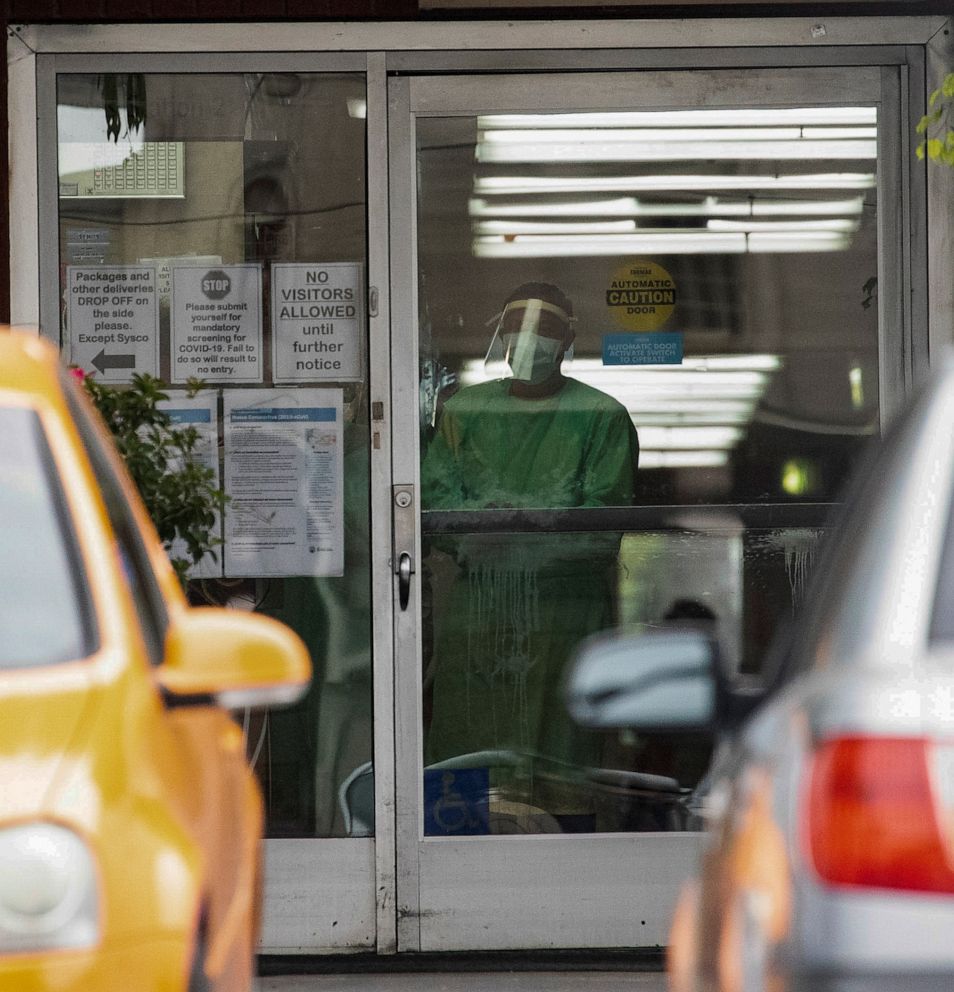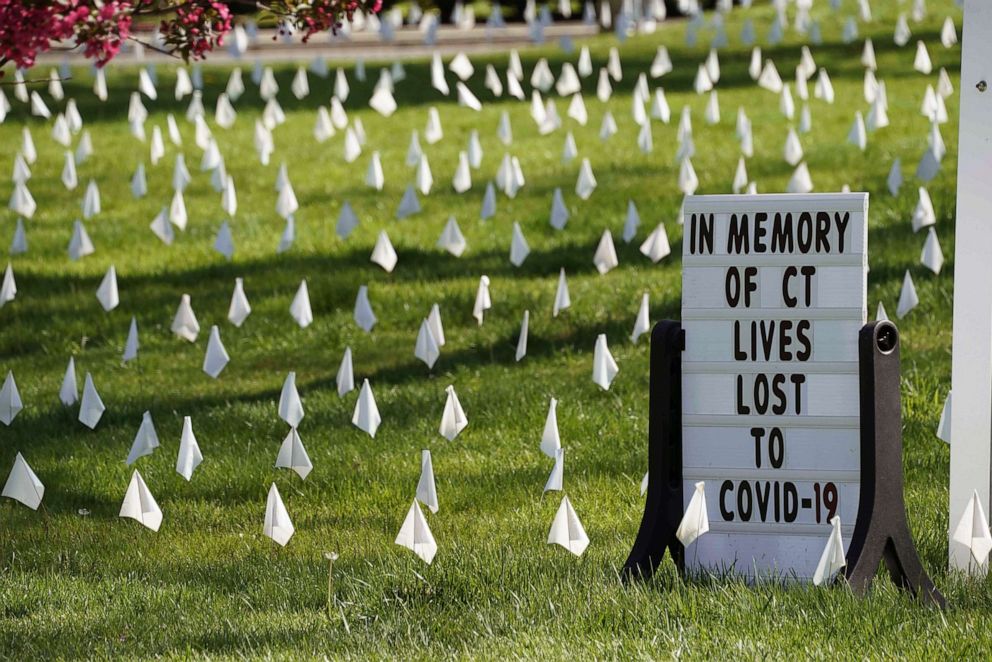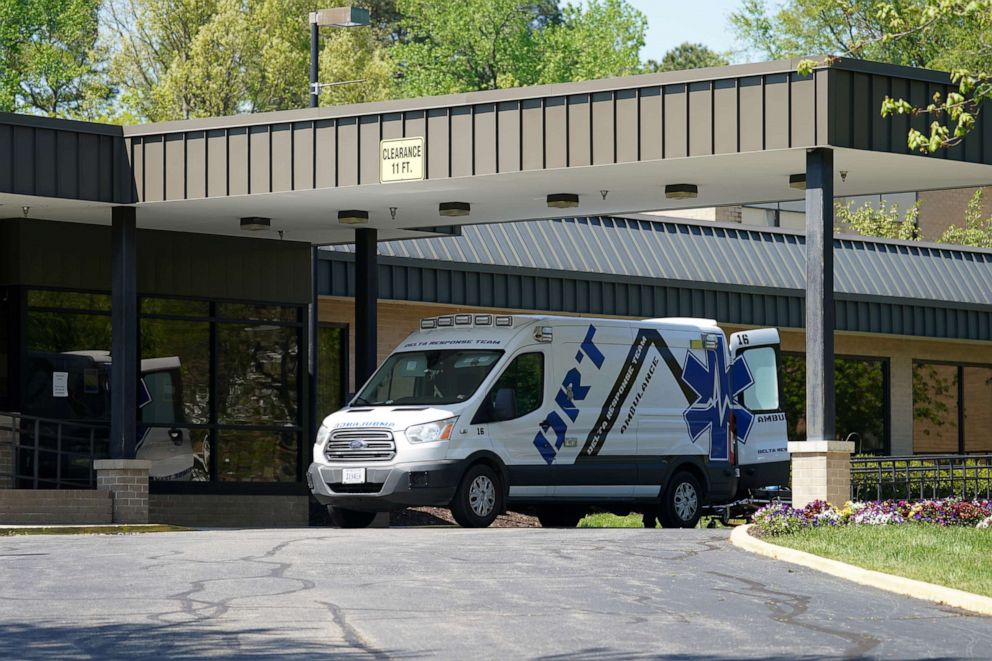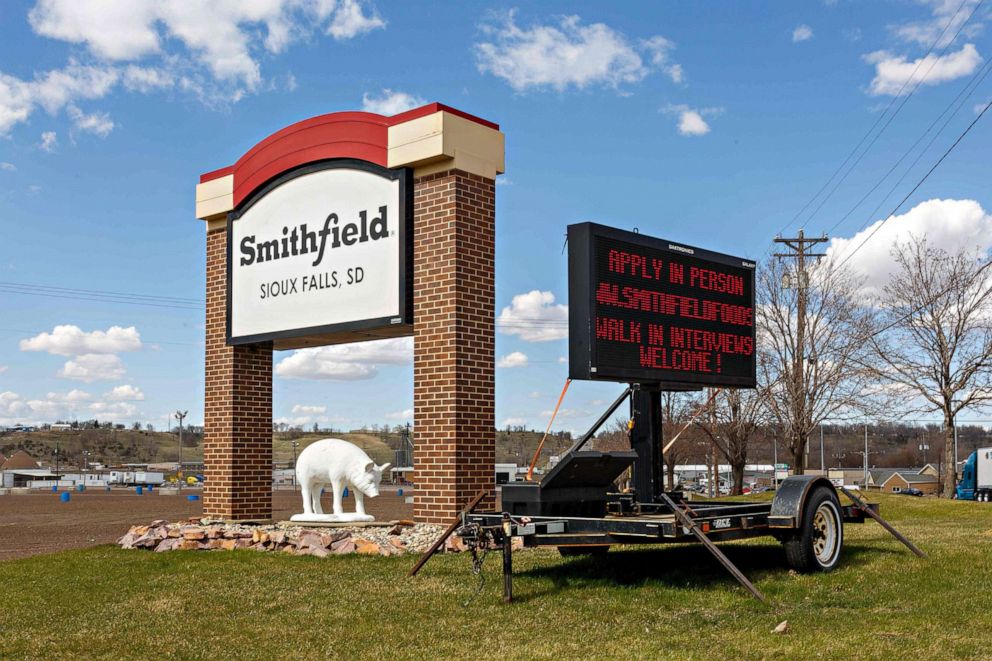Like ‘stationary cruise ships’: Prisons, factories emerging as deadly coronavirus transit hubs
Nursing homes now account for majority of COVID deaths in some states.
The spread of novel coronavirus has been turbocharged in institutional settings such as prisons and food processing plants, public health officials said, and state data analyzed by ABC News now point to those facilities as a crucial focus as the virus moves from urban centers to deadly clusters throughout rural America.
“Crowding is like fuel for the pandemic,” said Dr. Mark Abdelmalek, an ABC News medical contributor. “People are fully mixing and paths intersecting frequently.”
The deadliest place for COVID-19 transmission remains in nursing homes, which now account for more than 26,000 deaths in the U.S., according to public figures released by 35 states and Washington, D.C. That means that of the data available, nursing homes account for one-third of the nation’s fatalities from the ongoing viral outbreak, a new ABC News analysis shows.
Those grim totals reveal the extent of the lethal threat the virus poses in buildings full of frail, elderly occupants. But other densely populated facilities have also caught the attention of health officials.

Public health experts believe that prisons and industrial work sites where employees are closely packed – like meat and poultry processing plants – are fast becoming transit hubs for the microscopic predator, allowing it to migrate effortlessly from person to person and then fan out into the community.
“These are all environments where there is difficulty having social distancing, where there is uneven use of protective equipment, and as a result, where you are seeing significantly elevated risk,” said John Auerbach, a former senior official at the Centers for Disease Control and Prevention who now runs Trust for America’s Health, a non-profit advocacy.
Marc Perrone, president of the United Food and Commercial Workers, recently compared meat-packing plants to “stationary cruise ships.”
Conditions on cruise ships like the Diamond Princess, where more than 600 of the 3,711 passengers contracted the virus, offered one of the earliest clues that COVID-19 could spread easily in crowded, confined spaces.
Tune into ABC at 1 p.m. ET and ABC News Live at 4 p.m. ET every weekday for special coverage of the novel coronavirus with the full ABC News team, including the latest news, context and analysis.
In recent weeks, that same threat has surfaced in other crowded environments. In Maryland and Delaware, for instance, officials from the Center for Disease Control recently arrived to help health officials manage a growing numbers of cases in poultry processing plants.
“We started seeing reports more recently – about three to four weeks ago,” said Fran Phillips, Maryland’s deputy health secretary. “These are folks that work very close together. So it’s a large congregation of people. Many of whom drive together in carpools. This is a rural part of the state. These are low income people in crowded housing. It’s a compound of factors.”
This week, the state plans to begin testing all poultry factory employees, whether they are showing symptoms or not, Phillips told ABC News. That comes after just a week after the state announced universal testing in nursing homes, where more than half of the deaths have occurred.
“In both of these instances, with poultry plants and nursing homes, we expect to find people who are working who have the virus, don’t have symptoms, and they need to go home” and isolate themselves, Phillips said. “So we know what we’re doing is interrupting the infection.”

Phillips said it was important to note that the institutional settings are not the only places the virus us being seen and spread – that there is “community transmission” outside of those locations as well.
“There are very high case rates simply among the community itself. So we are attending to both things. To these hot spots,” she said. “But at the same time we’re looking out across the entire community and finding lots of virus out there as well.”
Still, on a White House conference call Monday, Texas Gov. Greg Abbott said that as his state reopens, he's focusing on three specific areas to get ahead of community spread: nursing homes, meatpacking plants and jails.
"What we have realized, just mathematically, is that if we can contain those three areas, we're going to be able to ensure there will be no community spread in the state of Texas and that will facilitate our ability to open up the state for doing business," Abbott said, according to a recording of the call obtained by ABC News.
Nursing homes: Deadliest outbreaks strike the most vulnerable
When reports surfaced in late February that the novel coronavirus had arrived on American shores, those initial viral imprints of what would eventually become a vast and vicious outbreak occurred in a modest long-term care home with 190 beds in suburban Seattle.
As the virus began to spread, nursing homes began instituting a series of measures to fortify the facilities. By the end of March, most homes had instituted bans on outside visitors. Communal activities were slowed or halted, group dining areas were shuttered. A number had devised strategies to immediately isolate residents who showed early symptoms of infection, such as a cough or fever.
"We were determined to do our best to contain it," said Dr. Mark Gloth, chief medical officer for HCR ManorCare, one of the nation’s largest nursing care chains, during a March 27 interview.
But during that early span, tests were hard to obtain, and results were slow to return. At the Canterbury Rehabilitation and Healthcare Center, it was not until April 2 that everyone in the facility could be tested – even though 16 residents had already died. When Virginia health officials saw the results, they were stunned. Of the 92 residents who tested positive, 53 still showed no symptoms.
“It's hard to know in the week or two weeks prior to this [discovery] how much potential transmission had been taking place, and I think that's the real challenge that all of us are facing with COVID-19,” said Dr. Danny Avula, Richmond’s health director. “So many people are spreading the virus before you even have symptoms, and I think that's clearly what's happened there at Canterbury.”

For about a week, Canterbury was the scene of the nation’s deadliest nursing home outbreak, with 50 dead. But death tolls were only starting to grow in facilities around the country. In one home in New Jersey, 70 residents died. At another in New York, 98 residents passed away.
State totals analyzed by ABC News have started to show the totality of the outbreak’s deadly imprint on nursing facilities. Available data from the 35 reporting states and D.C. shows there have been at least 26,013 nursing home deaths. That is 31% of the national death toll. And when adjusted to only include death counts of those states reporting, nursing home deaths make up 40% of the nation’s total number of fatalities.
In just four East Coast states – Massachusetts, New Hampshire, Pennsylvania and Rhode Island – two-thirds of the 8,447 people who have succumbed to the virus lived in nursing or long-term care facilities. All told, 14 states reported that nursing homes account for over half of their COVID-19 death toll, including in Maryland, where more than 800 have died.
Phillips, who is helping lead the state’s coronavirus response effort, said it has been hard to watch.
“We had a nursing home that had overwhelming outbreak in 48 hours,” Phillips said. “Because of the fragile nature of nursing home residents, if they do get infected, they’re much more likely have serious illness that can include fatal cases.”
Phillips said states like Maryland are trying to adapt quickly, adopting universal testing requirements so invisible carriers can be isolated even before they show symptoms, and bringing in “strike teams” of National Guard medics to support homes if the virus has infiltrated.
“We’re all in this together and throwing everything we can at it,” Phillips said.
Both Kentucky and South Carolina recently became some of the latest states announced aggressive new testing plans for nursing facilities in their states.
Prisons and jails: Locked up with COVID-19
The first federal prison inmate reported to have died from coronavirus was Patrick Jones. The inmate at the federal correctional complex in Oakdale, La., was serving a 27-year sentence for possession of crack cocaine. Jones’s mother told The New York Times she spoke with her son in March, while he was still healthy. On March 19 he was hospitalized, and nine days later he died at age 49.
Within three weeks, six more inmates at Oakdale had died, and at least 100 inmates and staff were infected.
“Everybody's scared,” said Ronald Morris, who heads the union representing Oakdale’s corrections staff. “They are worried that they're going to get it that they are going to bring it home to their families, and that they’ll introduce it into their communities.”
The Louisiana outbreak was one of the first indications of the deadly potential coronavirus could have inside prison walls.
During that period, cases surfaced at the Elkton federal prison in Ohio and in Cook County Illinois, where 13% of all inmates have either tested positive or recovered from COVID-19. Corrections officials had to build a temporary field hospital in the yard at the federal prison at Terminal Island in San Pedro, California. Nearly half of the 1,055 inmates there had tested positive by the end of April, according the Bureau of Prisons.
The numbers are striking. Across the federal system, 3,082 federal inmates and 248 staff have tested positive, with 45 deaths. Health department totals for the 47 states that track the numbers indicate at least 16,500 inmates in state prisons have tested positive and between federal and state prisons, over 300 have died. Data compiled by ABC News showed more than 6,000 corrections professionals at state and federal facilities have also tested positive for COVID-19.
Federal prison officials told ABC News that in facilities where they are testing, they expect the numbers to show the virus has spread even more widely.
"As in many other civilian areas experiencing outbreaks, increased testing has resulted in higher positive rates," a bureau spokeswoman said in a statement.
Prisons serve as an efficient incubator for the virus because of the close quarters and difficulty in social distancing.
“These environments require frequent and regular testing in a coordinated approach, especially to detect asymptomatic carriers of the coronavirus,” said Abdelmalek, the ABC News medical contributor. “Without testing, the asymptomatic carriers in these populations can cause widespread and quickly spreading outbreaks.”
Immigrant detention facilities are also showing signs that the virus represents a threat. Last week a 57 year old Salvadoran man died from COVID-19 at the Otay Mesa Detention Center in California. In a statement, Immigration and Customs Enforcement said the agency “is undertaking a comprehensive agency-wide review of this incident.”
Officials at prisons and detention centers have taken some steps to try and halt outbreaks, such as expanded testing, limiting visitation, keeping inmates in cells and isolating potentially infected inmates.
Attorney General William Barr issued federal guidance at several facilities that have been overrun by the pandemic – in Ohio, Connecticut and at Oakdale in Louisiana -- moving healthy prisoners out of the institutional settings and into home confinement. The BOP says it is working to identify potential home releases and will release inmates if they meet the attorney general’s criteria. More than 2,400 inmates have been moved so far, officials said.
“As BOP processes the inmates eligible for home confinement … and learns more about the COVID-19 pandemic and its effect on BOP facilities, it is assessing whether and how to otherwise priority consideration," a recent prison bureau court filing states.
In Maryland, Phillips said health officials have had success so far in limiting the outbreaks in prison by arranging for early release of certain non-violent offenders to help thin jail populations and by halting most transfers from one institution to another.
“Right now everything has been closed, has been frozen,” Phillips said. “We’re watching it very closely. We know what’s going on in other states.”
As supply lines stay open, fear enters food processing centers
In April, meat and food processing facilities began to emerge as a new hotspot for the virus.
There’s no confirmed number of how many of the 500,000 meat processing workers in the country were exposed to COVID-19, but when the CDC tested more than 130,000 workers at 115 facilities around the country they found 4,913 positive cases. Twenty workers who were found to be positive with COVID-19 have died.
While the average number of cases among workers in the facilities tested by CDC is 3% of employees, specific facilities with known outbreaks have infected more than 18% of the workforce.
In South Dakota, for example, a large Smithfield processing plant recently announced plans to reopen after closing due to a widespread infection. The state of South Dakota has less than 3,000 known cases of COVID-19 -- 3.3% of the population -- but more than 1,000 of the state’s cases were linked to the Smithfield pork processing plant in one county. There almost 800 employees who tested positive and more than 200 people who came in contact with an employee, according to the state department of health.

In Iowa, the CDC recorded that more than 18% of the workforce in two meat processing plants tested positive. On Tuesday, state health officials reported more than 1,600 workers at four plants tested positive.
Local public health officials around some of those plants reported concerns about spikes in cases related to the facilities, according to Iowa Public Radio, but many remained open to continue slaughtering and processing meat to be sold to consumers.
Iowa Governor Ann Reynolds and state Medical Director Caitlin Pedati said Thursday that regardless of what steps meat packing companies took at different stages of the outbreaks, the close proximity of workers in plants and similar spaces was the type of environment in which COVID-19 spreads.
The CDC says the virus spreads efficiently in meat processing workers because workers spend hours in conditions that make it nearly impossible to keep six feet of distance from others, the distance recommended by public health officials to impede the virus' spread.
On a meat processing line, workers spend hours in tight quarters reaching to break down pieces of meat, often taking lunch and bathroom breaks at the same time and frequently carpooling to and from work.
In some cases companies offered bonuses for people who kept working to meet demand for meat in grocery stores, which critics say also incentivized employees to come to work even if they were scared or feeling sick. Major meat packing companies like Tyson Foods and Smithfield have changed the benefit schedule and said employees who miss work due to illness will still qualify for the bonus.
A large percentage of workers in meat processing facilities are also immigrants or refugees who may not speak English well, creating language barriers with safety instructions from employers or CDC, and cultural barriers to make employees feel comfortable reporting an illness.
CDC and the Occupational Health and Safety Administration have issued guidelines to improve conditions that contribute to outbreaks in the plants, and companies like Smithfield and Tysons have implemented changes like barriers between work stations and temperature checks. Other steps taken by companies include wellness checks, installing barriers, and staggering break times.
But union officials and critics say that without requirements and more aggressive steps they could still see more outbreaks as plants stay open.
Phillips, the Maryland health official, said states are already at work trying to identify other institutional settings that the novel coronavirus may treat as fresh hunting grounds. That includes group homes for the developmentally disabled and homeless shelters.
“These are all places we want to jump on right away and make sure that if there is a smoldering infection there, we can get it before it becomes a very serious outbreak,” she said.
What to know about the coronavirus:
- How it started and how to protect yourself: Coronavirus explained
- What to do if you have symptoms: Coronavirus symptoms
- Tracking the spread in the U.S. and worldwide: Coronavirus map
ABC News' Katherine Faulders, Allie Pecorin and Soorin Kim contributed to this report.




